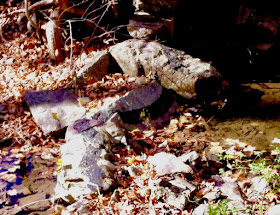
mill foundation wall drawing
charcoal with wall, kill and Earth
drawing area @2' x 6'
Valatie Kill
Valatie NY
10/26/16
Ω Stand With Standing Rock Ω
this drawing is at the "little falls" in the Village of Valatie where the Valatie Kill meets the Kinderhook, tr "children's corner", Creek... the stone foundations are remnants of the textile factories that flourished in the 1600's as the American Industrial revolution first developed in the Hudson Valley of NYS...
"Like many communities in New York’s Hudson River valley, Valatie was settled in the early seventeenth century by Dutch colonists. It’s pronounced “va LAY sha”, by the way, not “VAL-a-TIE”. The name comes from the Dutch “vaaltje” for “little falls”, after the small but scenic waterfall that commands the center of the village.
The original inhabitants of the area were, of course, Native Americans. The “Meeting Place” (“Pachaquack”) south of the “Great Fish Lake” (“Wogashawachook”), now Kinderhook Lake, may well have referred to the confluence of the Valatie Kill and the Kinderhook Creeks. And just east of the current village was Pompoonick, a Mohican settlement probably named after a local chief, Pompoen.
Records of the European settlement date back to about 1665. From the beginning, the abundance of water power provided by the two creeks supported the establishment of numerous mills in the area. As early as 1697, grist and saw mills had been erected on the banks of the streams. In 1817 Manchester, England, native Nathan Wild settled in Valatie. With two associates, he formed the Kinderhook Manufacturing Company, and began the spinning of cotton yarn and weaving cotton shirting by hand-looms. In 1828, the partners built a brick factory for sixty looms (a large mill at that time). In 1845 Wild visited England, and soon after his return he erected a factory for ten thousand spindles and two hundred looms."
- http://www.valatielibrary.net/about-valatie/



































